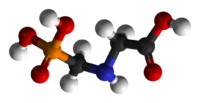
Photo from wikipedia
In the framework of this study, dicationic herbicidal ionic liquids (HILs) containing tetramethylene-1,4-bis(decyldimethylammonium) and dodecylmethylene-1,12-bis(decyldimethylammonium), including two different herbicidal anions exhibiting different modes of action, were synthesized and characterized. One… Click to show full abstract
In the framework of this study, dicationic herbicidal ionic liquids (HILs) containing tetramethylene-1,4-bis(decyldimethylammonium) and dodecylmethylene-1,12-bis(decyldimethylammonium), including two different herbicidal anions exhibiting different modes of action, were synthesized and characterized. One herbicide incorporated into the HILs was a tribenuron-methyl belonging to ALS inhibitors, while the second herbicidal anion was a synthetic auxin that acts as a growth regulator, namely 2,4-dichlorophenoxyacetate (2,4-D), 2-(2,4-dichlorophenoxy)propionate, (2,4-DP), 2,4,5-trichlorophenoxyacetate (2,4,5-T), 4-chloro-2-methylphenoxyacetiate (MCPA), 2-(4-chloro-2-methylphenoxy)propionate (MCPP), and 4-chlorophenoxyacetate (4-CPA). The obtained products were found to be unstable and decomposed, which can be attributed to the presence of an additional methyl group within the sulfonylurea bridge of the tribenuron-methyl. The synthesized HILs exhibited good affinity with polar and semipolar solvents, with ethyl acetate and hexane as the only solvents that did not dissolve the HILs. Greenhouse tests demonstrated that most of the obtained HILs were more effective than the reference herbicide containing tribenuron-methyl. The length of the alkyl chain in the cation also influenced the effectiveness of the HILs. Better effects were observed for dodecylmethylene-1,12-bis(decyldimethylammonium) cations compared to tetramethylene-1,4-bis(decyldimethylammonium). Therefore, the novel dicatonic HILs showed to integrate the advent of the combination of the different herbicides into a single molecule, enhance herbicidal efficacy, and reduce the risk of weed resistance due to the various modes of action of the applied treatment.
Journal Title: Journal of Agricultural and Food Chemistry
Year Published: 2022
Link to full text (if available)
Share on Social Media: Sign Up to like & get
recommendations!